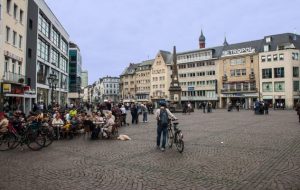 Movies and TV
Movies and TV  Movies and TV
Movies and TV  Health
Health 10 Miraculous Advances Toward Curing Incurable Diseases
 Miscellaneous
Miscellaneous 10 Undeniable Signs That People’s Views of Mushrooms Are Changing
 Animals
Animals 10 Strange Attempts to Smuggle Animals
 Travel
Travel 10 Natural Rock Formations That Will Make You Do a Double Take
 Movies and TV
Movies and TV 10 Actors Hidden in Your Favorite Movies
 Our World
Our World 10 Science Facts That Will Change How You Look at the World
 Pop Culture
Pop Culture 10 Incredible Female Comic Book Artists
 Crime
Crime 10 Terrifying Serial Killers from Centuries Ago
 Technology
Technology 10 Hilariously Over-Engineered Solutions to Simple Problems
 Movies and TV
Movies and TV 10 Movie Adaptions That Brought Popular Songs to Life
 Health
Health 10 Miraculous Advances Toward Curing Incurable Diseases
 Miscellaneous
Miscellaneous 10 Undeniable Signs That People’s Views of Mushrooms Are Changing
Who's Behind Listverse?

Jamie Frater
Head Editor
Jamie founded Listverse due to an insatiable desire to share fascinating, obscure, and bizarre facts. He has been a guest speaker on numerous national radio and television stations and is a five time published author.
More About Us Animals
Animals 10 Strange Attempts to Smuggle Animals
 Travel
Travel 10 Natural Rock Formations That Will Make You Do a Double Take
 Movies and TV
Movies and TV 10 Actors Hidden in Your Favorite Movies
 Our World
Our World 10 Science Facts That Will Change How You Look at the World
 Pop Culture
Pop Culture 10 Incredible Female Comic Book Artists
 Crime
Crime 10 Terrifying Serial Killers from Centuries Ago
 Technology
Technology 10 Hilariously Over-Engineered Solutions to Simple Problems
10 Curious Musical Compositions Created by Science and Technology
Technology and art have always advanced together. Innovations in materials lead to new mediums for artistic expression or improvements of old ones. In recent times, engineers and scientists from diverse fields have used their knowledge to find new ways to compose music unlike any heard before.
Today we are able to listen to music composed by, rather than inspired by, Mother Nature. The melodies of mathematics and statistics are as accessible as Mozart’s music. Here are ten examples of science and technology turned into music.
Related: 10 Cutting-Edge Uses Of Laser Technology
10 Seismic Activity
Fifty seismographs capture the 1,500 to 2,500 earthquakes at Wyoming’s Yellowstone National Park each year. The supervolcano there is almost always experiencing seismic activity, something which inspired the composer and physicist Dr. Domenico Vicinanza to organize a unique concert at a conference in May 2023. He designed a computer program to convert the seismic activity—traditionally represented by a needle etching on paper—into music in real time. The music could then be performed live on the flute.
The program works by translating the amplitude of the vibrations into musical pitch, so larger vibrations are represented by higher notes. However, this unusual compositional method is not a mere musical curiosity. Dr. Vicinanza explains it will help scientists to investigate the patterns, peaks, and troughs which characterize seismic activity. He also believes it will help promote the idea that science can be enjoyed by everyone.[1]
9 The Solar System
Seismic activity was not the first scientific data Dr. Vicinanza turned into music. In 2014, he turned 37 years of data gathered by NASA’s two Voyager space probes into music for orchestra and piano. The result is surprisingly upbeat; space sounds more like the excited opening of Jupiter from Holst’s “The Planets” suite or Star Wars than the vast, slow magnificence of Strauss’s “Also Sprach Zarathustra,” better known as the opening to 2001: A Space Odyssey.
Dr. Vicinanza combined data from 320,000 hourly proton count measurements taken simultaneously by both spacecraft, billions of kilometers apart. He turned this into two exciting, interweaving melodies where listeners can hear the patterns, changes, regularities, and shapes in the data.[2]
8 The Southern Ring and Carina Nebulae
In 2022, a team of scientists and musicians created sonifications of images taken by the James Webb telescope to help the visually impaired distinguish the key features of each image. Features such as the location, color, size, brightness, and age of each star in the two nebulae were translated into sounds using predefined musical parameters. The result is two surprisingly distinct pieces, with the Carina Nebula’s pleasantness counterbalanced by the Southern Ring’s uncomfortable dissonance.
The team also composed a third piece based on the atmosphere spectrum of the hot gas giant planet WASP-96 b. Although their primary goal is to help visually impaired enthusiasts understand the images through sound, they hope music’s ability to reach people’s emotions will help the James Webb telescope’s discoveries interest a wider audience.[3]
7 Molecules
It is not only physicists and astronomers who benefit from sonification; biologists have joined in too. One who has benefited is molecular biologist Mark Temple, who found that the four bases of human DNA were easy to map to musical notes. The short melodies helped him identify patterns while conducting vital research on cancer treatments. In fact, they were more effective than the overwhelming visual displays.
Later, he created his own software to convert data to sound and began to add more instruments like guitars and drums to turn viruses, hormones, and proteins into music. However, he stresses that “musification” is different from “sonification,” with the latter aiming to provide information and avoid creative input, like a heart rate monitor or police siren. While molecular music may be less scientifically useful, he believes it can help improve scientific communication. During the pandemic, he worked with musician friends to produce a rock song from the COVID-19 virus.[4]
6 The City of Bonn, Germany

In litigious societies, it can be difficult for filmmakers to find music to feature in their videos. The most certain way to avoid a copyright claim is to have original music composed, but this option is unavailable to most people. However, it was available to staff at the University of Bonn. In need of music for teaching and training videos, staff at the university partnered with students studying sound design.
The students had a unique approach to composition—they took their recording equipment out into the city of Bonn to capture sounds which they could later turn into samples. Each student was tasked with capturing 20 sounds. Noises, including beer bottles popping, birds tweeting, and a spray can, were worked into full tracks for university staff to use.[5]
5 A Philosopher’s Brainwaves
“All brains are musical—you and I are symphonies.” This is the belief of Dan Lloyd, who, while a professor of philosophy at Trinity College in Connecticut in 2016, decided to test his hypothesis that the dynamics of brain activity resemble those of musical compositions. He partnered with a local neuropsychiatry research center to capture the brain activity of fellow philosopher Daniel Dennett using functional Magnetic Resonance Imaging (fMRI).
He sonified 8,000 3D images of the eminent philosopher’s brain using familiar musical instruments and scales. He chose this approach because he believes humans are adept at interpreting and filtering information when it is presented in a familiar way. He imagines this could eventually lead to a kind of fMRI stethoscope to help diagnose mental illnesses. For now, only Daniel Dennett’s brain is available to listen to. How different this deep thinker’s mind is from the rest of mankind remains to be seen.[6]
4 The Northern Lights
Alaskan composer Matthew Burtner grew up hearing stories of sounds produced by the aurora borealis, otherwise known as the Northern Lights. He was finally able to solve the mystery in 2021 when the BBC commissioned him to compose a piece of music for their radio documentary “Songs of the Sky” and equipped him with very low-frequency recorder. The device turns electromagnetic signals, including those produced by the Northern Lights, into sound waves so that they can be heard.
However, it is not easy. The equipment is so sensitive it picks up sounds from almost everything, meaning Burtner had to travel many miles away from any human activity. He described the original sounds of the lights as snapping and crackling, but they were unclear, so he reproduced them using electronic synthesizers. Able to hear more clearly, he then mapped them onto parts for musical instruments. The completed composition, “Auroras,” attempts to sonically capture the feeling of seeing the lights outside on a clear night.[7]
3 Lamborghini Engines
In 2022, supercar manufacturer Lamborghini’s sound engineers worked together with music producer Alex Trecarichi to answer an intriguing question: What songs would a powerful Lamborghini engine become if it were turned into a piece of music? They approached the task by capturing the vibrations of V8, V10, and V12 engines across their entire spectrum, from the low rumble of idling engines to their most powerful roar.
Once they had gathered the data, measured in hertz, mathematical formulas were applied to break it down into musical subcomponents, which could be tested for similarities with existing pieces of music. Rather than composing original pieces, the Lamborghini team worked to produce three “Engine Songs” playlists comprising music that matched up with the sounds of each engine.[8]
2 Polestar 2 Car Parts
Many people listen to music in cars, but cars are rarely heard in music. In 2021, German musician and robotics engineer Moritz Simon Geist sought to remedy this. He started by building robots from parts of the popular Swedish electric car. Each robot either produced a sound or had changes in its electromagnetic field recorded to make samples for Moritz to use. Both were necessary because the car is engineered to minimize vibrations, making it difficult to find sounds to record.
Moritz also focused on extracting sound waves from the car’s electric components so that the samples are specific to electric vehicles. He arranged his samples into an original piece of music, “Sound of the Soul,” using the car parts like an orchestra. The samples were also released to the public so that they could create their own music.[9]
1 Climate Change
Sonification of data helps people interpret complex data by wrapping it up in things like music, which they understand more intuitively than numbers on a spreadsheet. Therefore, it is no surprise that scientists have sonified one of the most important and difficult topics affecting the world today: climate change.
In 2018, a team comprising UC Berkeley graduates and a sonification artist from Stanford composed a piece of music based on 1,200 years of climate change data, specifically the correlation between atmospheric CO2 levels and global average temperatures from AD 850 to 2016. The music helps people experience the impact of climate change over time. When seen on a graph, the data shows very little change before a steep rise from around 1700 to the present time.
But it is hard to imagine how so much time passing with no climate change actually feels and how dramatic the recent rise has been. Scientists say music allows people to experience time in a way looking at a chart does not. The piece is soothing and pleasant at the beginning but quickly rises in intensity toward the end when it begins to sound like the siren of an ambulance. The scientists hope this will help people understand their frightening and urgent message.[10]








